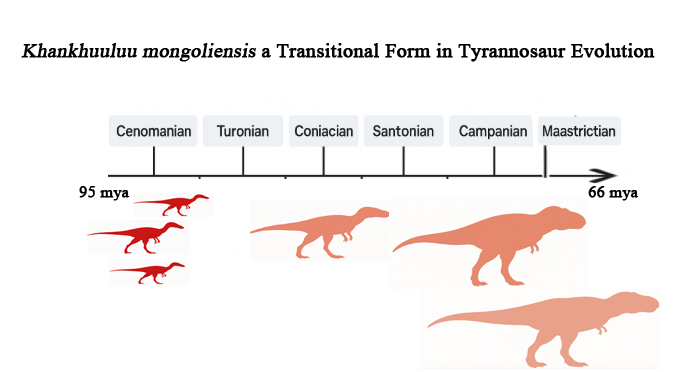A new species of tyrannosauroid described by scientists as a “missing link” sheds new light on the evolution of Late Cretaceous tyrannosaurs. The dinosaur, named Khankhuuluu mongoliensis represents a transitional form between the small, gracile early tyrannosauroids and the giant, bone-crushing, apex predators such as Daspletosaurus and Tyrannosaurus rex. The large tyrannosaurs from the end of the Cretaceous (Campanian and Maastrichtian) have been intensively studied. However, the evolutionary origins of these super-sized theropods remains poorly understood. It is known that these dinosaurs evolved from much smaller ancestors. The discovery of Khankhuuluu (pronounced: khan-KOO-loo), helps palaeontologists to fill in a gap between these ancestral forms and the Late Cretaceous giants.

Khankhuuluu mongoliensis represents a transitional form between small tyrannosauroids of the early Late Cretaceous and the giants of Campanian and Maastrichtian. Yes, I know Maastrichtian is not correct in the diagram :). Picture credit: Everything Dinosaur.
Picture credit: Everything Dinosaur
Khankhuuluu mongoliensis
A team of researchers led by scientists from the University of Calgary (Alberta) have described a new species of tyrannosauroid from the Upper Cretaceous Bayanshiree Formation of southeastern Mongolia. University of Calgary PhD student Jared Voris found unique autapomorphies in two fossil specimens that had been assigned to the tyrannosauroid Alectrosaurus. For example, an air cavity was identified in the nasal bone and the student found other traits that indicate this dinosaur was evolving the skull anatomy that would generate immense bite forces.
Phylogenetic analysis suggests that K. mongoliensis sits just outside the Eutyrannosauria. This is the clade which contains giant tyrannosaurs such as Gorgosaurus, Lythronax, Tarbosaurus and T. rex as well as, smaller more lightly built predators.
The Eutyrannosauria is split into two tribes:
- Alioramini (for example Qianzhousaurus and Alioramus): smaller, slender, shallow-skulled forms.
- Tyrannosaurini (for example Tyrannosaurus rex): massive, deep-skulled forms.
Khankhuuluu and the Alioramini both share certain traits. They are lightly built, have long hind limbs and shallow skulls. These characteristics are seen in juvenile specimens of the giant tyrannosaurs such as Tarbosaurus and T. rex. These traits evolved due to heterochrony, meaning changes in the timing of growth during evolution. Writing in the journal “Nature” the research team which included Professor Darla Zelenitsky (University of Calgary) suggest that accelerated growth led to the evolution of the giant forms of tyrannosaur (peramorphosis). In contrast, the Alioramini retained juvenile traits into adulthood (paedomorphosis). This explains, their smaller size and gracile build.
It is postulated that the different body types of the Alioramini and Tyrannosaurini likely helped them live side by side in Asia by filling different ecological roles.
The Prince of Dragons
The fossils were discovered in the 1970s at the Baishin-Tsav locality (Bayanshiree Formation). The strata are believed to have been laid down in the Turonian to Santonian faunal stages of the Late Cretaceous. The fossils of Khankhuuluu mongoliensis are thought to be approximately 86 million years old. Khankhuuluu is estimated to have weighed around 750 kilograms and measured around four metres in length.
The dinosaur’s name translates as “Mongolia’s Prince of Dragons”. It hints that this theropod was a prince that led to the evolution of the “tyrant kings”.
The Everything Dinosaur blog has documented numerous articles about new discoveries leading to the erection of new Tyrannosauroidea taxa. Most of these dinosaurs were considerably smaller than Khankhuuluu.
To read about the discovery of a small-bodied tyrannosauroid from southern Laramidia: Suskityrannus – The Shape of Things to Come.
The contemporary Timurlengia from Uzbekistan: New Dinosaur Sheds Light on How Tyrannosaurs Got Big.
Moros intrepidus, a member of the Superfamily Tyrannosauroidea from Utah: Moros – A Diminutive Tyrannosauroid.
Alioramini Not a Basal Lineage
Previously, phylogenetic analysis had relied too much on immature specimens, and this led to the assumption that the Alioramini were a primitive, early diverging group. However, the researchers postulate that the Alioramini were not basal, but more derived representing theropods that retained immature features into adulthood.
Furthermore, the study reveals that Asian tyrannosauroids (similar to Khankhuuluu) dispersed to North America. They gave rise to the Eutyrannosauria. The Eutyrannosauria diversified and remained exclusively in North America until a single dispersal to Asia in the latest Cretaceous that established the Alioramini and Tyrannosaurini tribes.
The scientific paper: “A new Mongolian tyrannosauroid and the evolution of Eutyrannosauria” by Jared T. Voris, Darla K. Zelenitsky, Yoshitsugu Kobayashi, Sean P. Modesto, François Therrien, Hiroki Tsutsumi, Tsogtbaatar Chinzorig and Khishigjav Tsogtbaatar published in Nature.
The Everything Dinosaur website: Dinosaur Models and Toys.




Leave A Comment